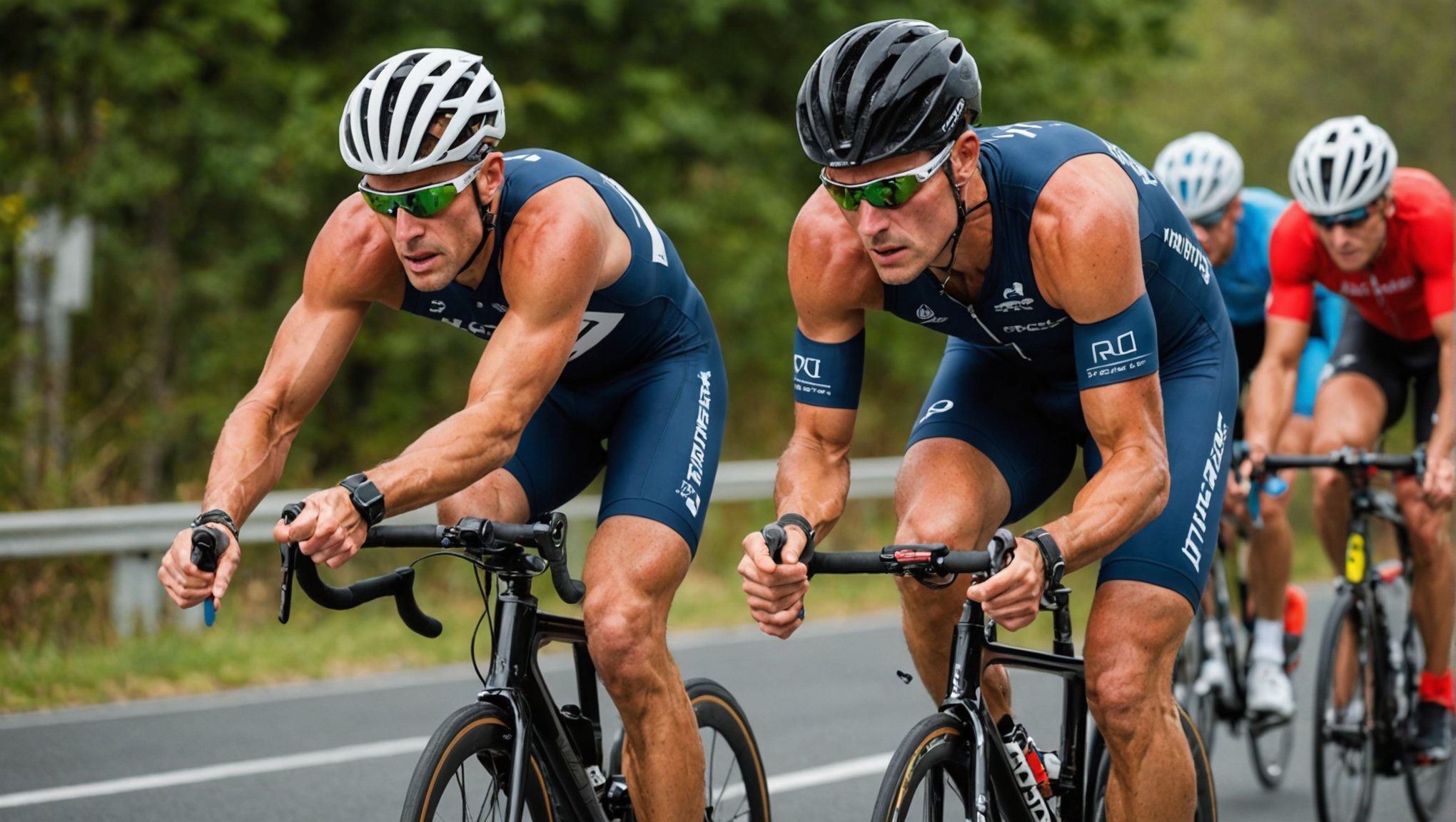Maximizing Triathlon Performance: Real-Time Insights on Training Intensity and Lactate Threshold
Understanding the Basics of Triathlon Training
When it comes to triathlon training, the key to success lies in a well-structured and scientifically informed approach. For endurance athletes, understanding the intricacies of training intensity and lactate threshold is crucial for optimizing performance.
The Role of Lactate Threshold
Lactate threshold (LT) is a critical metric in endurance training. It represents the intensity at which the body starts to accumulate lactic acid in the muscles, marking the transition from aerobic to anaerobic metabolism. For triathletes, knowing their lactate threshold heart rate (LT1) is essential because it indicates the maximum sustainable effort level over a prolonged period.
Additional reading : Top Footwear Innovations to Minimize Impact for Long-Distance Trail Runners
As Nikki Bartlett, a professional triathlete, noted, “My lactate threshold (LT1) heart rate dropped by 15 beats, the most substantial change I’d ever experienced in my career.” This significant change highlights the importance of monitoring and adjusting LT1 to optimize training.
Heart Rate Training Zones: A Comprehensive Guide
Heart rate training zones are a fundamental tool for triathletes to gauge their exercise intensity. Here’s a detailed look at these zones and how they apply to triathlon training.
Also read : Mastering Heat Acclimation: The Ultimate Guide for Marathon Runners to Optimize Training
The Five Heart Rate Training Zones
| Zone | Perceived Effort Level | HR Level |
|---|---|---|
| Zone 1 | Very Easy – feels almost too simple | 55% – 65% Max HR |
| Zone 2 | Aerobic Base – conversation is possible | 65% – 75% Max HR |
| Zone 3 | Tempo – challenging | 75% – 85% Max HR |
| Zone 4 | Lactate Threshold – high intensity | 85% – 88% Max HR |
| Zone 5 | Anaerobic – absolute peak effort near capacity | 88% + Max HR |
- Zone 1: This is the recovery zone, ideal for warm-ups, cool-downs, and easy runs. It helps in improving cardiovascular health without exerting too much stress on the body.
- Zone 2: The aerobic base zone is where most of your training should occur. It’s the zone where you can still hold a conversation, indicating that you’re working at a sustainable intensity. Allocating 40% to 50% of your training time here is recommended.
- Zone 3: The tempo zone is challenging but manageable. It’s used for building endurance and speed. This zone should constitute about 10% to 15% of your training.
- Zone 4: This is the lactate threshold zone, where you’re working at a high intensity. It’s crucial for improving your anaerobic capacity and should make up about 5% to 10% of your training sessions.
- Zone 5: The anaerobic zone is for short bursts of maximum effort. It’s used sparingly, typically less than 5% of your total training time, due to its high intensity and potential for overtraining.
Crafting a Personalized Training Plan
To maximize performance, a personalized training plan is essential. Here are some steps and tips to help you create an effective plan:
Assessing Your Current Fitness Level
Before diving into a new training plan, it’s crucial to assess your current fitness level. This can be done through various tests, including lactate threshold testing, which provides invaluable insights into your physiological capabilities.
Allocating Training Time
- Zone 1 and Zone 2: These zones should make up the bulk of your training, around 80% of your session time. This ensures you build a strong aerobic base and improve your endurance.
- Zone 3, Zone 4, and Zone 5: These higher intensity zones should be used more sparingly. Zone 3 for tempo runs, Zone 4 for lactate threshold training, and Zone 5 for short, intense intervals.
Incorporating High-Intensity Interval Training (HIIT)
HIIT workouts are designed to push your heart rate up and down repeatedly, improving aerobic capacity, sprinting ability, and overall endurance. Here’s an example of how to incorporate HIIT into your training:
- Warm-Up: Start with a 10-15 minute warm-up in Zone 1 or Zone 2.
- Interval Bursts: Alternate between high-intensity intervals (Zone 4 or Zone 5) and recovery periods (Zone 1 or Zone 2).
- Cool-Down: Finish with a 10-15 minute cool-down in Zone 1.
Monitoring Progress and Adjusting Intensity
Monitoring your progress is vital to ensure your training is effective and to avoid overtraining.
Tracking Heart Rate Trends
Regularly reviewing your heart rate trends can show improvements in running pace, distance traveled, and workout duration. Here are some key metrics to track:
- Resting Heart Rate: An increase in resting heart rate can be a signal of overtraining. Keep an eye on this metric to adjust your training volume or pattern accordingly.
- Workout Heart Rate: Compare your heart rate during workouts over time. A decrease in heart rate at the same intensity indicates improved cardiovascular fitness.
- Perceived Effort: Pay attention to how you feel during workouts. If you find that you can sustain higher intensities with less effort, it’s a sign of improved fitness.
Adjusting Training Based on Data
Data doesn’t lie, and regularly reviewing your training data can help you make informed decisions.
- Adjust Training Volume: If you notice improvements in your performance metrics, you may need to increase the intensity or volume of your training.
- Consider External Factors: Factors such as temperature, altitude, hydration, and recovery time should all be taken into consideration when adjusting your training plan.
Practical Insights and Actionable Advice
Here are some practical tips to help you maximize your triathlon performance:
Use Lactate Threshold Testing
Lactate threshold testing is considered the gold standard for establishing threshold values. It provides a precise measure of your anaerobic threshold, helping you tailor your training to your specific physiological capabilities.
Incorporate Interval Training
Interval training, especially HIIT, is highly effective for improving endurance and anaerobic capacity. Here’s a detailed example of an interval workout:
- Warm-Up (10 minutes in Zone 1)
- Interval 1: 4 minutes in Zone 4, 2 minutes recovery in Zone 1
- Interval 2: 3 minutes in Zone 5, 3 minutes recovery in Zone 1
- Cool-Down (10 minutes in Zone 1)
Stay Hydrated and Recover Properly
Proper hydration and recovery are crucial for maintaining performance and avoiding overtraining. Ensure you drink enough water before, during, and after your workouts, and allocate sufficient time for recovery between sessions.
Maximizing triathlon performance is a multifaceted endeavor that requires a deep understanding of training intensity, lactate threshold, and heart rate zones. By crafting a personalized training plan, incorporating high-intensity interval training, and regularly monitoring your progress, you can optimize your training and achieve better results.
As a scholar in the field of sports science would advise, “The key to successful endurance training is a balanced approach that includes both high-intensity and low-intensity training, tailored to the individual’s physiological capabilities”.
By using tools like lactate threshold testing, heart rate monitoring, and interval training, you can ensure that your training is both effective and sustainable, leading you to peak performance in your next triathlon.






